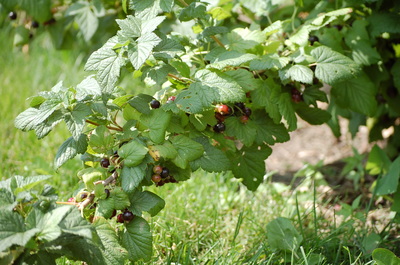Common Name: European Blackcurrant
Scientific Name:
Family: Grossulariaceae
Genus: Ribes
Species: nigrum
Hardiness Zone: 3 to 7
Height: 3 to 4 ft
Width: 3 to 4 ft
Common Characteristics:
European black currant is a small, woody shrub that is primarily grown for fruit production. It is a medium-sized shrub reaching 3-6′ in height and width, Greenish-yellow flowers bloom in spring. The flowers are noticeable but not known for being ornamental. The flowers give way to long, pendant clusters of berries, known as black currants, which ripen in June-July. Leaves are green and have 3-5 lobes. They are aromatic when crushed. Plants usually reach their fruit-bearing potential in 4-5 years.
Where it Grows:
This shrub does well in organically rich, well-drained soil. Prefers full sun to partial shade. European black currant likes cool summer climates but part afternoon shade is tolerated in hot summer climates. Plant in areas that will be protected from strong winter winds and frost. They do not tolerate drought. Generally tolerant of urban conditions.
How it's Used:
It can be planted as an ornamental landscape shrub. The berries can be used to make preserves, jams, jellies, sauces, and juice. The berries are also used in dietary supplements. The shrub likes compost mulch for the root zone. Water regularly as needed to keep soils uniformly moist, but avoid overwatering. Prune annually. It is suggested to remove stems older than two years to enhance plant health and food production.
Ecosystem Services:
Birds are attracted to the berries but are more of a last resort for them in the fall and winter months.
Where it is Native To:
European black currant is native to Europe but grows well in USDA Hardiness Zones 3 - 7.
Known Varieties and Their Traits:
- 'Consort' Black Currant - Grows to be about 4 feet tall at maturity, with a spread of 3 feet. It tends to fill out right to the ground and therefore doesn’t necessarily require facer plants in front. It grows at a medium rate, and under ideal conditions can be expected to live for approximately 20 years.
Problems:
There are no serious disease or insect problems. They are an alternate host for white pine blister rust, a fatal disease for white pines. It should not be planted in any area where the disease is prevalent. In areas where the disease is not prevalent, it is best to avoid planting in locations where white pines are growing unless rust-immune cultivars (e.g., 'Consort') are used.
References:
